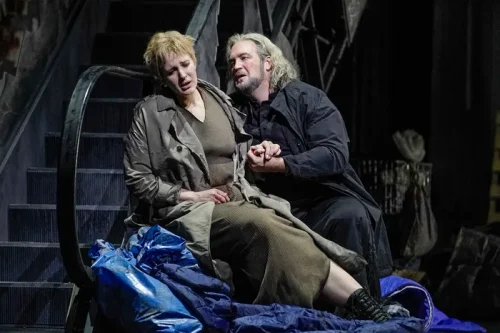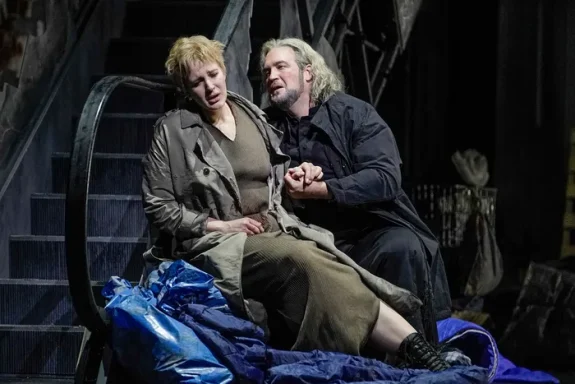 United States Verdi, La forza del destino: Soloists, Chorus and Orchestra of the Metropolitan Opera, New York / Yannick Nézet-Séguin (conductor). A Live in HD broadcast (directed by Gary Halvorson) from New York’s Metropolitan Opera to Cineworld Basildon, Essex, 9.3.2024. (JPr)
United States Verdi, La forza del destino: Soloists, Chorus and Orchestra of the Metropolitan Opera, New York / Yannick Nézet-Séguin (conductor). A Live in HD broadcast (directed by Gary Halvorson) from New York’s Metropolitan Opera to Cineworld Basildon, Essex, 9.3.2024. (JPr)

Production:
Production – Mariusz Treliński
Set designer – Boris Kudlička
Costume designer – Moritz Junge
Lighting designer – Marc Heinz
Projection designer – Bartek Macias
Choreographer – Maćko Prusak
Chorus master – Donald Palumbo
Live in HD Host – Nadine Sierra
Cast:
Leonora – Lise Davidsen
Don Alvaro – Brian Jagde
Don Carlo – Igor Golovatenko
Preziosilla – Judit Kutasi
Fra Melitone – Patrick Carfizzi
Marquis de Calatrava / Padre Guardiano – Soloman Howard
Curra – Stephanie Lauricella
Mayor – Christopher Job
Trabuco – Carlo Bosi
Surgeon – Paul Corona
The plot of the Verdi’s La forza del destino takes a tragic turn during Act I which casts a dark shadow over the rest of the opera, and this is of course foreshadowed by the famous ‘fate’ motif, the three Es played in unison by the brass which develops in the strings. We will then hear that theme reoccur time and again throughout the opera. La forza was written for St Petersburg, where a first version premiered in 1862. The opera begins with the Marquis of Calatrava interrupting the planned elopement of Don Alvaro – originally conceived as the son of a Spanish grandee and Inca princess – and his daughter Donna Leonora. Since Alvaro is mixed-race he is considered an unsuitable match. Calatrava is accidently killed and Leonora’s brother Carlo vows to avenge his father’s death by killing Alvaro and his sister; and this will consume him for the rest of the opera. Right from the start there was a serious problem with La forza: the fallout from Calatrava’s Act I curse on the lovers eventually resulted in the death of too many characters for the sensibilities of those seeing and hearing it for the first time in 1862.
In 1869 Verdi revised La forza – with Antonio Ghislanzoni’s additions to Francesco Maria Piave’s original libretto – attempting to find what he called ‘that damned ending’. This time he was more successful, restructuring the opera’s four acts so each had a distinctly different character. The curse remained, as did most of the deaths, yet the overall impression of the opera was far less depressing. Significant changes were the now very familiar overture; an additional final scene to Act III, following the duel between Carlo and Alvaro; and a new ending, in which Alvaro remains alive, instead of throwing himself off a cliff to his death. It is this 1869 version – which was well received – that has survived to become popular with admirers of Verdi; though it was 2006 when it was last seen at the Met.
Regardless – even in this version – La forza is no masterpiece though it provides a showcase for some great singing. It is a very uneven work with the ‘heroine’ offstage for all of Act III and the final act’s opening scene, and there are any number of improbable events, changes of tone, concealed identities and shifts in time and place. The musical influences on Verdi are numerous and often La forza is reminding you of something else, particularly Wagner’s Tannhäuser with its ‘fate’ motif, pilgrims’ chorus and Leonora’s concluding ‘Pace, pace mio Dio!’ And especially because of those ‘changes of tone’ and, rare for Verdi, some intentional laughs – in, for instance, the Act III Trabuco and Act IV Fra Melitone scenes – you’ll definitely be thinking about Donizetti too.
For directors, staging this almost four-hour work often means a similar struggle to that which concerned Verdi. Having abandoned the classical demands of unity of action, as well as ‘time and place’; in La forza the time span is extremely large, and the locations move back and forth, over large geographical distances.
Mariusz Treliński’s production was seen in January 2023 at the Polish National Opera and – according to the director and set designer (Boris Kudlička) – it is set in the twentieth century and reflects how war is cruel, chaotic and bloody. It is important to understand that the war in Ukraine is only across the Polish border. I have been revisiting – thanks to an obscure TV channel – the first series of Mission Impossible dating from 1966, they always seem to be in an ‘Eastern Bloc’ country up against an unhinged megalomaniac threatening the US. Oddly, Hotel Calatrava we now see during the overture – where military dictator ‘General’ Calatrava and his daughter also seem to live – reminded me of the milieus I am seeing in those MI episodes.
Before we hear any music Leonora bursts out the hotel’s doors, anxious and smoking. Once the orchestra begins playing the set revolves and we see Leonora’s birthday party which a caption (the first of several during the opera) projected on a screen has told us we are watching. Leonora roams around angrily trying to break free from her stifling life and arranging with Curra, her maid, to make her escape with Alvaro. Eventually, Calatrava and Alvaro confront each other – and in an admittedly risible bit of stage action – a dropped gun on the floor somehow shoots the general in his back, triggering all the tragic events, including all-out war.
For Act II we are in a 1990s nightclub where Carlo is fuelling his anger by drinking heavily. I was not sure what some things added to this, such as, a chorus line of scantily clad, reimagined Bunny Girls, or the fortune-teller Preziozilla declaiming the glories of war in tones more appropriate to Turandot against the backdrop of a burning planet, or the (obligatory?) restroom scene where I could not understand why Carlo did not recognise Leonora. In between the two scenes of Act II, we see a film of a Leonora racing away from encountering her vengeful brother and crashing her car in torrential rain; wounded and bloodied she ends up at a monastery. Soloman Howard is double cast as Padre Guardiano and Leonora’s father who will haunt the remainder of the opera. Until he gets interrupted was Guardiano developing an unhealthy interest in Leonora? As the Virgin Mary appears to Leonora (and is ‘seen’ floating above the stage) Leonora is scourged by the monks before living the rest of her life as a hermit.
The final two acts bring us settings familiar from any number of current ‘modern-day’ opera productions; for Act II there is a barbed wire encampment with an army hospital which showcases solo moments and impassioned duets for Alvaro and Carlo (both initially giving false names) and their impassioned duets, as well as Preziosilla’s ‘Rataplan’. This is her call to arms, rousingly sung by the Met’s chorus (who were magnificent throughout) but it just holds up the plot. Images of war included Apocalypse Now-like helicopters and a film of a helmeted soldier trudging through a forest (neither very original). Act IV is usually in and around a monastery but we are now in a (familiar again?) bombed-out New York subway station full of the hungry and homeless casualties of war who have turned to the church for food (just like the food banks of our current times). After the longueurs of the Fra Melitone scene which no one would surely miss if it was cut, Leonora – no longer in a mountain cave – pushes along a shopping trolley full of the few possessions she has and prays for peace. After a final confrontation between Carlo and Alvaro, the opera rushes to its downbeat conclusion with Leonora forgiving Alvaro as she dies (having been stabbed by her brother) and Guardiano – in the guise of General Calatrava – suggesting Alvaro seek redemption from God.
Throughout this La forza there was a suitably melodramatic sound from Yannick Nézet-Séguin and his remarkably disciplined Met Orchestra which supported all the onstage histrionics. Because Nézet-Séguin is such a singers’ conductor there was no danger he would overwhelm his principals whose singing was stylistically mostly some old-fashioned, face-forward can belto. From the long overture onwards there were many virtuosic solo moments from Nézet-Séguin’s musicians when there was no singing (such as from clarinettist Anton Rist in the overture and in Act III).

I wasn’t entirely convinced by Lisa Davidsen’s acting during Act I and with her reappearance in Act II when she just looked grumpy and morose. She won me over with her exhausted Joan of Arc transformation in Act III where it is obvious Leonora is giving up on life. The high points of Davidsen’s singing in this role debut were – as they surely must be – her Act II ‘Madre, pietosa Vergine’ and Act IV ‘Pace, pace, mio Dio!’ Davidsen was totally in control of her darkish sound – darker I would suggest than is usual for the big Verdi soprano roles – and her voice rose from its warm depths to glowing heights and top notes which pinned this listener to his cinema seat. Depending on the mood of the music Davidsen’s soprano showed it could also demonstrate the most exquisite refinement.
I had my doubts too about Brian Jagde’s Alvaro. Overall, I didn’t find his acting entirely convincing, though again, he was at his best in his heartrending final moments with Leonora at the end of the opera. Whilst his Act III ‘La vita è inferno all’infelice … O tu che in seno agli angeli’ was sung as if it was a Met Opera gala. Neither Davidsen nor Jagde were well-served by the preponderance of extreme close-ups from veteran Live in HD director Gary Halvorson.
Undoubtedly, Igor Golovatenko proved to be the best singing-actor in this performance clearly knowing how to beautifully – if that is the right word? – use his expressive and resonant Russian baritone sound to shape the role of Carlo. This included showing how fanatically hellbent his character is on making his sister Leonora (and Alvaro too) pay the ultimate price for their father’s death.
There is an imposing gravitas to Soloman Howard’s authoritative bass voice which was ideal for his dual roles as Calatrava and Guardiano, though I find Howard somewhat too stoical as a performer. Making much of the little Verdi gives them were the outstanding vignettes from Stephanie Lauricella’s loyal Curra; Patrick Carfizzi’s uncharitable Melitone; and Carlo Bosi’s Trabuco, who is initially a chauffeur and later a Dulcamara-like black-marketer. The one singer not on the level of those around her was the miscast Judit Kutasi as a very disappointing Preziosilla, sung without any vocal allure.
In the end I did enjoy this La forza, but it is not an opera I am in any rush to see again because of its sprawling nature and incoherence.
Jim Pritchard
For more about The Met; Live in HD click here.
